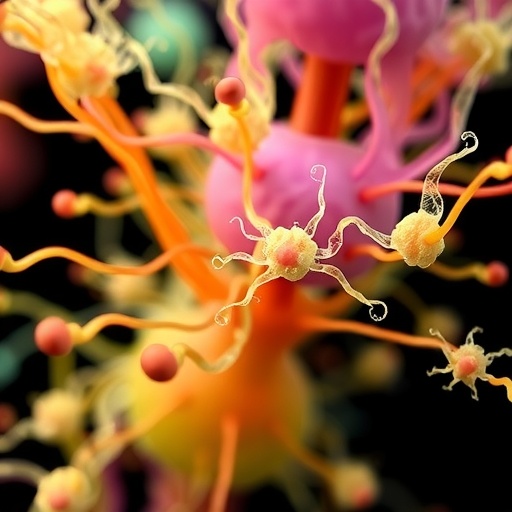In a groundbreaking study published in the journal Trends in Biotechnology, researchers have unveiled a remarkable innovation that could transform the textile industry forever. Imagine a future where the apparel you wear is produced not from toxic petrochemicals but from living microorganisms. This exciting research, conducted by a team at the Korea Advanced Institute of Science and Technology, showcases how bacteria can not only generate sustainable fabrics but also dye them with a spectrum of vibrant colors, all within a single production process. Such a revolutionary approach promises to disrupt traditional textile manufacturing practices that are dependent on harmful chemicals and non-renewable resources.
At the core of this research is a substance known as bacterial cellulose, a fibrous network created by certain microbes during fermentation. This unique material has recently gained traction as a viable alternative to synthetic fibers, traditionally sourced from petroleum, such as polyester and nylon. Conventional textile manufacturing is notorious for its negative environmental impact, largely due to reliance on carcinogenic dyes, heavy metals, and endocrine disruptors used in the dyeing process. The authors of this study aim to diminish the industrial carbon footprint and promote eco-friendliness by harnessing the power of nature to produce both fiber and color without the toxic consequences of traditional methods.
In their quest to develop colored bacterial cellulose fibers, the researchers faced significant challenges early on. Initially, attempts to co-culture cellulose-producing bacteria with color-producing bacteria resulted in poor outcomes; either the cellulose production was minimally effective or the cultures failed to achieve any notable pigmentation. This issue highlighted the fundamental incompatibility between the two bacteria species, namely Komagataeibacter xylinus, which synthesizes cellulose, and Escherichia coli, known for its capacity to produce vibrant pigments.
Undeterred, the research team meticulously adjusted their approach to overcome these hurdles. They devised a novel method called delayed co-culture, whereby the color-producing E. coli bacteria were introduced into the culture after the cellulose bacteria were already well-established. This sequential introduction allowed each type of microbe to thrive and effectively perform its respective function without impeding the operation of the other. For the pigments ranging from red to yellow (carotenoids), they developed a sequential culture strategy, where cellulose was first harvested, purified, and then immersed in the pigment-producing E. coli cultures. These adjustments resulted in the successful creation of a broad range of colored bacterial cellulose sheets featuring hues that included purple, navy, blue, green, yellow, orange, and red.
To ensure the practicality of these bacteria-derived textiles, the researchers conducted rigorous durability tests. They subjected the colored fabrics to washing, bleaching, heating, and even exposure to acidic and alkaline conditions to assess whether the vivid colors could withstand the rigors of everyday use. Remarkably, most of the tested materials retained their vibrant colors, and the violacein-based textile demonstrated superior performance in wash tests compared to conventional synthetic dyes that often fade over time.
Despite these promising initial results, the research’s lead author, San Yup Lee, notes that this innovative bacteria-based fabric technology may take five years to make its way into retail markets. This timeline is primarily attributed to the need for scaling up production processes, as well as the challenge of competing against the low-cost production of petroleum-based textiles. Furthermore, public perception plays a crucial role in the acceptance of such sustainable solutions; there is a pressing need to shift consumer mindset towards choosing eco-friendly products over cheaper, traditional alternatives.
The ecological implications of this study are profound. The textile industry is notorious for its contribution to pollution and environmental degradation, and this research signifies a significant stride towards rectifying those practices. By replacing harmful synthetic fibers with bioengineered alternatives, the prospect of reducing greenhouse gas emissions and conserving natural water resources becomes tangible. As Lee articulates, it is humanity’s duty to nurture and protect the environment for future generations, highlighting a conscientious approach to textile production that seeks to benefit both the planet and its inhabitants.
Moreover, the financial and logistical challenges ahead cannot be understated. A shift in policy and consumer behavior, alongside enhanced production capabilities, will be critical for the successful integration of these biofabric technologies into mainstream textile manufacturing. However, as awareness grows regarding the environmental costs of conventional textiles, there is hope that innovative solutions, such as those presented in this research, will find their knees within sustainable markets.
The pioneering work showcased in Trends in Biotechnology underscores a crucial crossroads faced by the global textile industry. As society begins to prioritize ecological sustainability, this research sends a clarion call for transformation in how materials are sourced and produced. It opens a dialogue on the importance of integrating biotechnology into traditional sectors, thereby fostering a new era of innovation that aligns economic viability with environmental preservation.
While the current study may not immediately revolutionize the textile world, it represents a key step toward envisioning a sustainable future. With further advancements and collaborations between biotechnologists and the textile industry, such creative initiatives could redefine our understanding of materials and lead to a promising, eco-friendlier world filled with colorful, bacteria-made garments.
This revolutionary research is supported by the Development of next-generation biorefinery platform technologies for leading bio-based chemicals industry project and the Development of platform technologies of microbial cell factories for next-generation biorefineries project, both funded by the National Research Foundation of the Korean Ministry of Science and ICT. As the scientific community continues to explore the applications of microbial technology, this study serves as a beacon of hope for sustainability and environmental responsibility across industries.
Subject of Research:
Article Title: One-pot production of colored bacterial cellulose
News Publication Date: 12-Nov-2025
Web References:
References:
Image Credits: Credit: Zhou et al., Trends in Biotechnology
Keywords
Tags: bacterial cellulose textilesbiodegradable textile alternativeseco-friendly textile innovationenvironmentally friendly apparelgreen biotechnology in fashionliving microorganisms in textilesmicrobial dyeing processesnon-toxic dyeing methodsreducing industrial carbon footprintrevolutionizing textile manufacturing practicessustainable fabric productiontextile industry transformation





